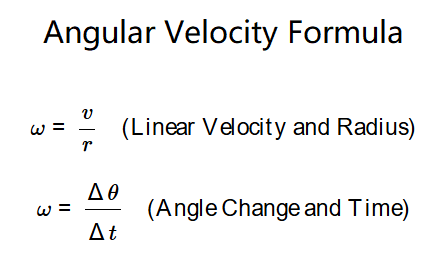 Home
Home
 Back
Back

Definition: This calculator computes the angular velocity (\(\omega\)) of an object in rotational motion, either using linear velocity and radius or angle change over time.
Purpose: It is used in physics, engineering, and astronomy to analyze rotational speed in systems like wheels, planets, or machinery. Angular velocity measures how fast an object rotates around a fixed point or axis.
The calculator uses these formulas:
Explanation: Input velocity and radius, or angle change and time, in your chosen units. The calculator converts inputs to base units (m/s, m, rad, s) and outputs angular velocity in rad/s, °/s, RPM, and Hz.
Unit Conversions:
Details: Angular velocity is key for understanding rotational dynamics, designing machinery, and studying celestial motion. For example:
Applications: This concept connects linear and rotational motion, making it essential for designing motors, analyzing orbits, and optimizing mechanical systems.
Tips: Select a method, enter positive values (except angle, which can be negative) with up to 2 decimal places, and choose units. Results are in rad/s, °/s, RPM, and Hz. Avoid zero radius or time. Small values (< 0.0001) are shown in scientific notation.
Example: If a wheel with a 50 cm radius spins at 10 m/s:
Angular Acceleration: The rate of change of angular velocity (\(\alpha = \frac{\Delta\omega}{\Delta t}\)) is closely related and often used with this calculator.
Centripetal Acceleration: For circular motion, \(a_c = v^2 / r = \omega^2 r\), linking angular velocity to the force keeping an object in its path.
Period and Frequency: The time for one revolution (period, \(T\)) is \(T = \frac{2\pi}{\omega}\), and frequency (\(f\)) is \(f = \frac{\omega}{2\pi}\), measured in Hz, as shown in the results.
Q: What’s the difference between rad/s, RPM, and Hz?
A: Rad/s measures angular speed in radians (\(2\pi\) rad = 1 revolution), RPM counts revolutions per minute, and Hz counts cycles per second (\(1 \, \text{Hz} = 1 \, \text{cycle/s}\)).
Q: Can I use negative values?
A: Yes, for angle change, a negative value indicates opposite rotation. Velocity, radius, and time must be positive.
Q: Why does the result show zero?
A: If radius or time is zero, division by zero occurs, so results default to zero.
Q: Why are some results in scientific notation?
A: Values less than 0.0001 are displayed as, e.g., \(1.23 \times 10^{-5}\), for readability.
Q: What if my units aren’t listed?
A: Convert to a supported unit first (e.g., km/h to m/s: \(\times 0.27778\)). The calculator handles listed units automatically.